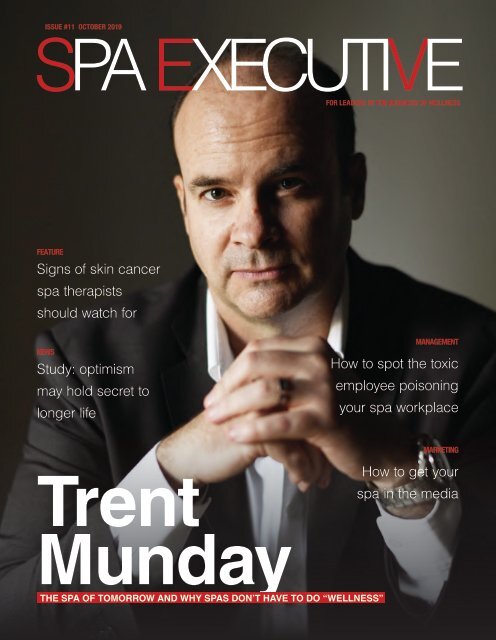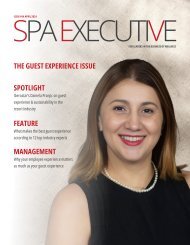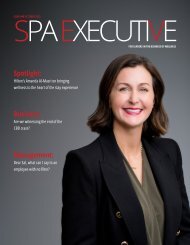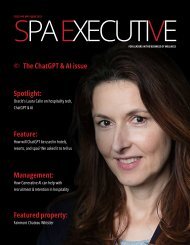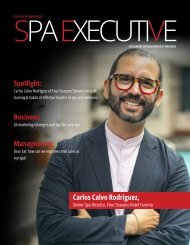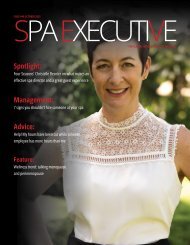Create successful ePaper yourself
Turn your PDF publications into a flip-book with our unique Google optimized e-Paper software.
ISSUE #<strong>11</strong> OCTOBER <strong>2019</strong><br />
SPA EXECUTIVE<br />
FOR LEADERS IN THE BUSINESS OF WELLNESS<br />
FEATURE<br />
Signs of skin cancer<br />
spa therapists<br />
should watch for<br />
NEWS<br />
Study: optimism<br />
may hold secret to<br />
longer life<br />
MANAGEMENT<br />
How to spot the toxic<br />
employee poisoning<br />
your spa workplace<br />
MARKETING<br />
Trent<br />
How to get your<br />
spa in the media<br />
Munday<br />
THE SPA OF TOMORROW AND WHY SPAS DON’T HAVE TO DO “WELLNESS”
PUBLISHER<br />
Roger Sholanki<br />
EDITOR<br />
Elizabeth Bromstein<br />
DESIGNER<br />
Shajee Aijazi<br />
Note from the Publisher<br />
What is a spa?<br />
We found ourselves asking this in this month’s issue of <strong>Spa</strong> <strong>Executive</strong> when talking with Trent<br />
Munday of Mandara <strong>Spa</strong> about the future of spas and wellness, specifically tackling the question<br />
of whether spas have to incorporate “wellness.”<br />
“Wellness is a concept the spa industry has latched onto as our latest shiny new thing,” said<br />
Munday, but it’s not something spas have to do. Munday believes that the <strong>Spa</strong> of Tomorrow will<br />
be a multi-functional, multi-disciplinary type of facility -- 20% what it is now (massage, facial, etc.)<br />
and 80% something else, which could be anything. “Maybe a business center or coworking<br />
space in a corporate city hotel,” he said. “Maybe a live, organic restaurant, kitchen, and cultural<br />
center in a remote resort hotel. The 80% is not only different from what we have today, but can<br />
vary dramatically from one spa to another.”<br />
This leads to the question, “What is a spa, anyway?” Munday points out that there is still a<br />
debate over whether a spa has to have water elements to qualify as a “spa.” Mineral rich water<br />
for bathing was once the single defining factor of a spa. Now, we seem to agree that it’s<br />
massages, facials, and other treatments that make a spa a spa. But are you still a spa if you are<br />
largely a business center that offers massages and facials? Munday says, “Why not?”<br />
What do you say? What do you think makes a spa? It’s worth thinking about as our industry<br />
moves into this future where anything is possible, and exploring where we can take our<br />
businesses. There may be no right answer. But it’s a great place to start.<br />
<strong>Spa</strong> <strong>Executive</strong><br />
The online magazine for <strong>Spa</strong><br />
<strong>Executive</strong>s, featuring news<br />
and exclusive interviews.<br />
Roger Sholanki,<br />
CEO<br />
Book4Time
Contents<br />
<strong>October</strong> <strong>2019</strong> Volume <strong>11</strong><br />
3<br />
NEWS<br />
Study finds optimism may be<br />
the secret to longevity<br />
3<br />
4<br />
6<br />
TRENDS<br />
Bakuchiol: a gentler alternative<br />
to retinol<br />
MANAGEMENT<br />
How to spot the toxic employee<br />
poisoning your spa workplace<br />
8<br />
MARKETING<br />
How to get your spa in the<br />
media<br />
10<br />
BUSINESS<br />
How to improve your online<br />
reputation<br />
15<br />
12<br />
15<br />
GROWTH<br />
Look inside the Albamhor <strong>Spa</strong><br />
at Scotland’s Fife Arms Hotel<br />
SPOTLIGHT<br />
Trent Munday on the <strong>Spa</strong> of<br />
Tomorrow and why spas don’t<br />
have to do “wellness”<br />
19<br />
TECHNOLOGY<br />
Should your spa be a<br />
technology free space?<br />
20<br />
FEATURE<br />
Signs of skin cancer spa<br />
therapists should watch for<br />
8 12
WELLNESS<br />
Study finds<br />
optimism<br />
may be the<br />
secret to<br />
longevity<br />
New research has found that more optimistic<br />
people are more likely to live longer and to live<br />
past the age of 85.<br />
According to a media release, “optimism” refers<br />
to “a general expectation that good things will<br />
happen, or believing that the future will be<br />
favorable because we can control important<br />
outcomes.”<br />
Past research has identified risk factors that<br />
increase the likelihood of disease and<br />
premature death, but less is known about<br />
psychosocial factors that can promote or<br />
impede healthy aging.<br />
The study — by researchers at Boston<br />
University School of Medicine (BUSM), National<br />
Center for PTSD at VA Boston Healthcare<br />
System, and Harvard T.H. Chan School of<br />
Public Health — included 71,173 subjects:<br />
69,744 women and 1,429 men. These<br />
completed surveys to assess their optimism<br />
levels, as well as their overall health and lifestyle<br />
habits such as diet, smoking and alcohol<br />
consumption. Men were followed for 30 years,<br />
while the women were followed for only 10<br />
years.<br />
The researchers found that the most optimistic<br />
men and women demonstrated an average <strong>11</strong> –<br />
15 percent longer lifespan, and had 50 – 70<br />
percent greater odds of reaching the age of 85<br />
compared to the least optimistic groups. This<br />
held after controlling for factors like age,<br />
education, chronic disease, depression, and<br />
health behaviors, including diet and exercise.<br />
“While research has identified many risk factors<br />
for diseases and premature death, we know<br />
relatively less about positive psychosocial<br />
factors that can promote healthy aging,” said<br />
corresponding author Lewina Lee, PhD, in a<br />
statement. “This study has strong public health<br />
relevance because it suggests that optimism is<br />
one such psychosocial asset that has the<br />
potential to extend the human lifespan.<br />
Interestingly, optimism may be modifiable using<br />
relatively simple techniques or therapies.”<br />
The researchers don’t know exactly how or why<br />
optimism correlates with comparative longevity.<br />
“Other research suggests that more optimistic<br />
people may be able to regulate emotions and<br />
behavior as well as bounce back from stressors<br />
and difficulties more effectively,” said senior<br />
author Laura Kubzansky, PhD. The researchers<br />
suggest that optimistic people may have<br />
healthier habits, such as being more likely to<br />
engage in more exercise and less likely to<br />
smoke.<br />
“Research on the reason why optimism matters<br />
so much remains to be done, but the link<br />
between optimism and health is becoming<br />
more evident,” said senior author Fran<br />
Grodstein, ScD. “Our study contributes to<br />
scientific knowledge on health assets that may<br />
protect against mortality risk and promote<br />
resilient aging. We hope that our findings will<br />
inspire further research on interventions to<br />
enhance positive health assets that may<br />
improve the public’s health with aging.”<br />
03 | <strong>Spa</strong> <strong>Executive</strong> News
BAKUCHIOL<br />
A GENTLER ALTERNATIVE TO RETINOL<br />
If you’re in any area of spa and wellness related to skincare, you’ve probably already heard of<br />
bakuchiol. This plant-based skincare ingredient is all the rage right now as a potential natural<br />
alternative to retinol, and those in the know haven’t been able to get enough of it for the past<br />
couple of years.<br />
Retinol, a Vitamin A derivative, has long been considered the gold standard in anti-aging skincare<br />
ingredients, known for its ability to improve fine lines, acne and pigmentation. But it’s also hard to<br />
tolerate for those with sensitive skin and conditions like eczema. Bakuchiol, by contrast, seems to<br />
do all that retinol does while being gentler on the skin. A compound obtained mainly from the<br />
seeds of the Psoralea corylifolia, which is also known as babchi or bakuchi, and is widely used in<br />
Eastern medicine, bakuchiol has been moving in as a potential rival to retinol’s rule.<br />
Trends<br />
<strong>Spa</strong> <strong>Executive</strong> | 04
A study published recently in the British journal<br />
of dermatology concluded that “bakuchiol is<br />
comparable with retinol in its ability to improve<br />
photoaging and is better tolerated than retinol.<br />
Bakuchiol is promising as a more tolerable<br />
alternative to retinol.” And another study<br />
published a few years ago found that bakuchiol<br />
was associated with “significant improvement in<br />
lines and wrinkles, pigmentation, elasticity,<br />
firmness and overall reduction in photo-damage<br />
… without usual retinol therapy-associated<br />
undesirable effects.”<br />
Some experts are cautious about getting too<br />
skincare products<br />
containing bakuchiol<br />
Whish Moisture Replenishing Day Cream<br />
All of Whish Beauty’s products are made with naturally<br />
sourced, organic ingredients. Among Whish’s products<br />
containing bakuchiol is the Moisture Replenishing Day<br />
Cream. This “ultra emollient” cream contains bakuchiol,<br />
terminalia chebula fruit extract, and organic rose hip oil to<br />
reduce the appearance of fine lines and wrinkles.<br />
excited with the retinol comparisons, as the<br />
research has not been very robust and more is<br />
required to determine if there are potential<br />
downsides or side effects. But that sort of thing<br />
doesn’t usually stop people from getting excited<br />
anyway.<br />
Over the past few years, bakuchiol has been<br />
making an appearance in skincare formulations,<br />
Alpyn Beauty PlantGenius Melt Moisturizer<br />
Alpyn Beauty is a sustainably sourced natural skin care line<br />
formulated with botanicals grown in the mountains<br />
surrounding Jackson Hole, WY. Alpyn’s PLANTGENIUS Melt<br />
Moisturizer is a cocktail of natural hydrators, antioxidants,<br />
and bakuchiol, among other things.<br />
like creams, masks and serums in spas all over<br />
the world.<br />
Omorovicza Miracle Facial Oil<br />
Budapest-based Omorovicza’s Miracle Facial Oil<br />
“replenishes like a rich cream yet absorbs instantly like a<br />
serum.” This award-winning product contains oils of sea<br />
buckthorn berry, rosehip and sweet almond hydrate;<br />
bakuchiol, and winged kelp extract.<br />
Oskia Super 16 Serum<br />
The Super 16 Serum is from Oskia, a “nutri-cosmeceutical”<br />
brand that “specialises in bio-cellular skin nutrition.” The<br />
serum contains 16 “super nutrients and bio-actives<br />
designed to boost collagen synthesis, lift and firm the skin<br />
and reduce fine lines.” These include bakuchiol, Opuntia<br />
Ficus-Indica Extract, Hyaluronic Acid , Vitamins C & E, and<br />
Crithmum Seaweed Extract.<br />
05 | <strong>Spa</strong> <strong>Executive</strong> Trends
HOW TO SPOT THE<br />
TOXIC EMPLOYEE<br />
POISONING YOUR SPA WORKPLACE<br />
Is there toxic employee poisoning your workplace? A toxic spa environment can be a problem, as<br />
we have discussed in the past. And it’s important to know what to do about it.<br />
There can be several causes, including broken communication lines and an unhealthy overall<br />
environment. But sometimes, all that toxicity is coming from one person. It can be someone in a<br />
management or non management role, and it can sometimes be difficult to figure out who it is.<br />
Like some actual poisons, toxicity isn’t always detectable to the naked senses. But if you pay<br />
close attention, you may be able to spot the toxic employee.<br />
This is important because a toxic worker can cost your company in employee turnover and in low<br />
morale, which can affect guest experience, among other things. A 2015 study by Dylan Minor at<br />
Harvard Business School defined a toxic worker as one that “engages in behavior that is harmful<br />
to an organization, including either its property or people.”<br />
Management<br />
<strong>Spa</strong> <strong>Executive</strong> | 06
Don’t let a toxic employee poison your spa<br />
workplace. To spot them, look for:<br />
A person who is very self regarding.<br />
Minor’s study found that people who are<br />
highly “self regarding,” as opposed to “other<br />
regarding,” are more likely to be toxic<br />
employees. A self regarding person does not<br />
“internalize the cost that their behavior<br />
imposes on others,” wrote Minor. “A way to<br />
capture one’s degree of other-regardingness<br />
is to identify how concerned one is about<br />
taking care of another’s needs.” This concern<br />
should impact the choices one makes, and<br />
someone who is more self regarding is,<br />
therefore, more likely to cause toxicity<br />
because they don’t care how their actions<br />
affects co-workers.<br />
Someone who is overconfident.<br />
According to Minor’s paper, overconfidence<br />
is an inflated belief in one’s own abilities that<br />
can be linked to engaging in misconduct.<br />
Someone who is overconfident believes that<br />
the probability of the better outcome is higher<br />
than it actually is. It makes sense to also<br />
associate overconfidence with higher self<br />
regard and a propensity towards always<br />
being right. Confidence is good.<br />
Overconfidence can be toxic.<br />
Someone who always insists on<br />
following the rules.<br />
This one is odd, but according to Minor,<br />
people who claim the rules should never be<br />
broken — as opposed to saying sometimes<br />
it’s necessary to break the rules to<br />
accomplish something — are significantly<br />
more likely to be terminated for breaking the<br />
rules. Minor suggests that this is a form of<br />
Machiavellianism of which we should be<br />
wary.<br />
Heightened tensions and drama when<br />
one person is around compared with<br />
when they are not.<br />
Moving away from Minor’s findings and into<br />
more general territory, if it feels like tensions<br />
tend to mount and fall on a regular basis, look<br />
around and see if there isn’t a common<br />
denominator. It could be just one person<br />
causing all that tension — if you can spot that<br />
person, you’re going to have to address it.<br />
“A way to capture<br />
one’s degree of<br />
other-regardingn<br />
ess is to identify<br />
how concerned<br />
one is about<br />
taking care of<br />
another’s needs.”<br />
The last one standing.<br />
I once worked at a company with a manager<br />
whose entire team kept getting fired one after<br />
the other. Project after project tanked under<br />
this person’s leadership, and yet she<br />
remained at the company while her<br />
employees kept getting let go – she even got<br />
promoted. At no point did her superiors ever<br />
seem to think maybe the problem was her,<br />
though everyone else around could see it<br />
plain as day.<br />
Someone who always has a problem.<br />
You know that one person who is never<br />
happy? Some of us might look for an<br />
explanation for this person’s constant<br />
complaints, assume that it’s our fault or<br />
someone else’s, or worry that they’re justified<br />
in some other way. But sometimes a person<br />
is just difficult and enjoys being unhappy –<br />
and that unhappiness will spread to the rest<br />
of your team.<br />
A person who is always right.<br />
We all know that person who can never back<br />
down and admit to being wrong. In an<br />
employee and colleague, this behavior can<br />
be very hard to handle and can certainly<br />
poison an atmosphere. One who is never<br />
wrong lacks humility, as well as the openness<br />
to learning that makes a great team member.<br />
Keep an eye out for the person who is never<br />
wrong. They are bad for any environment.<br />
Someone who seems to be at the top of<br />
the pecking order.<br />
You can’t always spot bullying but you might<br />
notice that a hierarchy has formed with a<br />
monarch at the top and subjects underneath<br />
who genuflect and vie for that person’s<br />
favour. This can seem benign on the surface<br />
but is an unhealthy peer structure that should<br />
be monitored. Nobody should be in charge<br />
but management, and even then nobody<br />
should be behaving like a queen bee.<br />
Back to Minor’s research, the study found,<br />
interestingly, that toxic workers are actually<br />
very productive, which may explain why<br />
managers tend to keep them around. But<br />
they’re still not worth it, because they ruin the<br />
work environment and can turn non-toxic<br />
workers into toxic ones. You’ve heard of the<br />
bad apple spoiling the whole bunch.<br />
Spotting the person presenting an issue is<br />
the first step towards fixing the situation.<br />
07 | <strong>Spa</strong> <strong>Executive</strong> Management
HOW TO GET YOUR<br />
SPA IN THE MEDIA<br />
BY CHRISTINA DAVES<br />
As a spa owner or manager, getting customers in the door is one of the most important aspects of your business.<br />
Advertising is one option, but that can get expensive. Have you ever considered pitching the media? There is no faster,<br />
more effective way to expose your business to thousands, hundreds of thousands, even millions of potential customers<br />
and the best part: it’s free.<br />
Here’s how to get your spa in the media<br />
People tend to be afraid of the media. They think it’s an exclusive club that only certain people are allowed to join. It is<br />
important to remember that media today is 24/7/365 so journalists need our story ideas. The key is creating good,<br />
newsworthy stories that will benefit that journalist’s specific audience. Take the time to do your homework and learn<br />
what type of story fits in the format of a particular media outlet.<br />
Marketing<br />
<strong>Spa</strong> <strong>Executive</strong> | 08
Then, implement my proven Get PR Famous Formula that will help you be more successful when pitching the media because you are giving them<br />
what they want. We’ve seen many people land media appearances in under 30 days and some in less than seven days. Getting local media<br />
coverage for your spa will get potential customers to learn about your business and get people in the door. Landing national media coverage gives<br />
you tremendous credibility with potential customers and also allows people who might be traveling to your area to learn about your business. The<br />
system works for either platform.<br />
Step 1 – Be Newsworthy<br />
Being newsworthy is thinking outside of the<br />
box when pitching the media. Don’t pitch a<br />
vanilla story that anyone else might pitch. Give<br />
them something of value they can share with<br />
their audience. You want it to be interesting,<br />
timely, and important.<br />
Here are some tips for creating newsworthy<br />
story ideas that will get your spa in the media:<br />
1<br />
Take a national trend or study and<br />
pitch yourself as the expert in your space. Is<br />
there a new wrinkle reducing treatment being<br />
recommended? What do you think about<br />
that? If you have a conflicting viewpoint, that is<br />
even better. The media likes to hear the other<br />
side of the story.<br />
2<br />
Niche your services and pitch around<br />
your specialty. Do you have a unique new<br />
treatment or piece of equipment that provides<br />
a service no one else has yet? Invite the<br />
media to come try it out and build a segment<br />
or story around that.<br />
3<br />
Sign up for Help a Reporter<br />
Out/HARO, www.HelpaReporter.com. This is<br />
a free media query service where media<br />
outlets are looking for sources and quotes for<br />
national magazine articles, television shows,<br />
newspapers, and blogs. I’ve worked with<br />
many people who have been featured in<br />
national media outlets through this service.<br />
Personally, I’ve appeared in over 1000 media<br />
outlets, many from HARO. They key to getting<br />
covered is in the response. Get my free guide<br />
for successfully responding to HARO queries<br />
at, www.FreeGiftFromChristina.com.<br />
Step 2 – Create Great Hooks<br />
The hook is your subject line. It’s how you<br />
entice the journalist to read your email pitch.<br />
Some national journalists will get 500 or more<br />
emails before noon on any given day. Your<br />
subject line has to stand out. What you see on<br />
magazine covers are essentially hooks. This is<br />
what the publisher uses to get you to make an<br />
impulse purchase in the grocery store line.<br />
You are not buying a magazine for the content<br />
in the article. You are buying based on the<br />
hook on the cover.<br />
My favorite examples of hooks are from AARP<br />
Magazine. Just Google, “AARP magazine<br />
covers” and see what’s there. Do the same for<br />
any spa, wellness or beauty related<br />
publications and see what they are using for<br />
hooks. Then, just plug and play your<br />
newsworthy story idea into a modification of<br />
an existing hook and you’re one step closer to<br />
success!<br />
Step 3 – Find The Right Journalist<br />
This step is vital because you don’t want to<br />
send your spa or wellness related story to the<br />
sports editor. People are always amazed at<br />
how frequently I get on television and in<br />
magazines and newspapers. It’s all about<br />
finding the right person to pitch. We have an<br />
amazing resource to do this right at our<br />
fingertips. It’s Google. Remember that Google<br />
is a question search engine, so input: “Who<br />
writes about skincare/wellness/health for<br />
[name of publication].” Locally, you’ll usually<br />
get their name, email, and phone number all in<br />
one search. National names can sometimes<br />
take a page or two of digging but they will be<br />
there. If the journalist you are trying to reach is<br />
on LinkedIn, a great resource to find their<br />
email address is, https://rocketreach.co.<br />
By putting these three steps in place when<br />
pitching the media, you will be light years<br />
ahead of your competition and you will stand<br />
out to journalists. The more you pitch well<br />
thought out, quality stories, the more you will<br />
be seen as a valuable resource to the media<br />
and the more you will see you, your spa, or<br />
your services in the media.<br />
09 | <strong>Spa</strong> <strong>Executive</strong> Marketing
HOW TO IMPROVE YOUR<br />
ONLINE REPUTATION<br />
As a spa, salon, or wellness business, much<br />
depends on your online reputation. There are<br />
a lot of spas and similar businesses out there,<br />
all offering the same or similar services. So,<br />
how is a potential customer to choose one<br />
over the other?<br />
What does Google say about you?<br />
One of the first ways people are going to find<br />
you is through your online presence. They’re<br />
going to Google you and they will be looking<br />
at your website, your social channels and<br />
your reviews on websites like Trip Advisor and<br />
Facebook, as well as on customers’ own<br />
social channels. And they have to like what<br />
they see.<br />
Research has found that a vast majority of<br />
people look online for businesses to<br />
patronize, while 85% of consumers trust<br />
online reviews as much as personal<br />
recommendations, and half of consumers<br />
need to see at least a four-star rating before<br />
they choose to use a business.<br />
Does your image need a some freshening<br />
up? Here are eight steps you can take to<br />
improve your online reputation.<br />
Business<br />
<strong>Spa</strong> <strong>Executive</strong> | 10
Do an audit of your online presence<br />
Your first step should be to Google your<br />
business and see what comes up on the first<br />
three pages. What do you find? If your<br />
website and social accounts come up, are<br />
they up to date and well maintained? Or do<br />
you get a Twitter account you haven’t posted<br />
on since 2015, a pinned post from eight<br />
months ago, and a one-star Trip Advisor<br />
review from that terrible, angry customer from<br />
three years ago? Not good. You have to do<br />
something about that.<br />
Monitor your presence<br />
You can also sign up for Google alerts so<br />
you’ll know when you’re name appears in the<br />
news. This is more useful for bigger<br />
businesses with unique names. Less so if<br />
your spa shares a name with several other<br />
spas, which is sometimes the case. You<br />
should also be closely monitoring your<br />
reviews.<br />
Clean up your blogs and social pages.<br />
If you do have unused social channels or an<br />
idle blog page, you should either update<br />
these or think about shutting them down.<br />
Unused pages look lazy and outdated.<br />
Unfortunately, they’re all too common. This is<br />
usually simply because life is busy and it’s<br />
hard to keep up with posting to blogs and<br />
social, especially when all that other work<br />
seems to much more pressing. But it’s<br />
important to remember that your online<br />
presence, which is part of your marketing<br />
and in some cases all of your marketing, is<br />
vitally important. Without it, people can’t find<br />
you. Or when they can find you, they might<br />
not like what they see and decide to go<br />
elsewhere. You have to keep up. Delete the<br />
unused social pages or update them.<br />
Bury the bad reviews with good ones.<br />
You can almost never have bad reviews<br />
removed from websites, but you can bury<br />
them with good ones. This means<br />
encouraging customers to write reviews.<br />
Keep in mind that people don’t usually even<br />
think of writing reviews when we’re happy.<br />
We’re far more likely to jump online when<br />
we’re mad and want to vent. But we might<br />
write one when asked nicely. Don’t be shy<br />
about asking in person (doing so can<br />
dramatically increase your chances of getting<br />
one, according to Marketing Land) and then<br />
you can follow up and make the request in an<br />
email. When you have enough positive<br />
reviews, the negative ones will hopefully be<br />
pushed to the bottom of the pile. Note, of<br />
course, that getting those glowing reviews<br />
begins with offering an excellent guest<br />
experience. So, do that first.<br />
Encourage clients to share on their own<br />
sites and social channels<br />
Happy guests should be encouraged to<br />
share photos and posts to their social<br />
accounts and to tag your spa. Putting up a<br />
selfie station is one way to encourage people<br />
to post about their experiences. You can also<br />
ask if you can take photos and tag them.<br />
Respond to reviews<br />
Since you can’t get rid of the bad reviews,<br />
you should be responding and, when<br />
possible, trying to turn things around.<br />
Connect with the guest and ask if there is any<br />
way you can make their experience better.<br />
People will see you engaging and appreciate<br />
your involvement. I always look to see if<br />
someone responds to negative reviews when<br />
evaluating a business. If they’re truly just<br />
difficult and you are in no way at fault, you<br />
might consider telling your side of the story.<br />
This is risky and can backfire, but it can also<br />
work. Also respond to positive reviews,<br />
thanking people for taking the time to leave<br />
one. Research shows that businesses that<br />
respond to reviews get more of them and<br />
have higher average star ratings.<br />
Get involved in the conversation<br />
Many brands don’t understand that content<br />
and social marketing is a conversation and<br />
that means it must go both ways. Gone are<br />
the days of sending out your message in one<br />
direction. You should not only be responding<br />
to reviews, but also responding to<br />
commentary on your social pages. Keep the<br />
conversation going, and be sure to comment<br />
on and engage with other people’s posts on<br />
Twitter, LinkedIn, and Instagram. Interact with<br />
others in a positive way and they will return<br />
the favour.<br />
Do some keyword research<br />
Look into what keywords you might use to<br />
increase your Google ranking, and incorporate<br />
them into your content. Do this as organically<br />
as possible, and resist the urge to overuse<br />
them or to “keyword stuff” as we call it.<br />
Keep it going<br />
Online reputation isn’t something you do<br />
once and then forget about. It is a constant<br />
process and you have to maintain it. Setting<br />
aside even one hour twice a week, or 20<br />
minutes a day, to check in and see what<br />
needs responding to and to take care of<br />
some posting to Instagram, Twitter, and<br />
Facebook, will help keep you on track.<br />
Maintaining your online reputation is work but<br />
it is necessary and will pay off in the long run.<br />
<strong>11</strong> | <strong>Spa</strong> <strong>Executive</strong> Business
Look inside the<br />
Albamhor <strong>Spa</strong> at<br />
Scotland’s<br />
Fife Arms Hotel<br />
The new Albamhor <strong>Spa</strong> at the Fife Arms, a boutique hotel in the Scottish<br />
Highland town of Braemar, has opened its doors, marking the completion<br />
of a three-year, multi-million dollar transformation project.<br />
Braemar is home to Scotland’s annual Highland Games, an event that<br />
attracts visitors from around the world. And the Fife Arms, a 46-bedroom<br />
property, which opened at the end of 2018, has already been dubbed<br />
“Scotland’s Hottest Hotel” by the Financial Times. Located in an old<br />
Victorian coaching inn, the property has been remodeled by its new owners<br />
Iwan and Manuela Wirth, co-Presidents of the international gallery Hauser &<br />
Wirth.<br />
Growth<br />
<strong>Spa</strong> <strong>Executive</strong> | 12
“Inspired by a deep sense of place, the colourful<br />
stories of Braemar, and the dramatic landscape of<br />
the Cairngorms, the hotel brings together a<br />
profound respect for local history, a love of nature<br />
and strong sense of community.”<br />
The Albamhor <strong>Spa</strong> is created by interior designer<br />
Russell Sage along with <strong>Spa</strong> Vision, which<br />
supplied and installed the bespoke sauna,<br />
treatment tables, and associated equipment.<br />
Colin Cameron, director at <strong>Spa</strong> Vision, said in a<br />
statement, ”The Fife Arms holds considerable<br />
history and a defining place in the local area. For<br />
this reason, the attention to detail and precision<br />
has been unwavering. The Albamhor <strong>Spa</strong> is a<br />
stunning addition to the hotel facilities and we are<br />
delighted to have played our part in bringing the<br />
designers’ vision to life.”<br />
Albamhor is the ideal place to “unwind and to<br />
restore, revive and relax body, mind and spirit.”<br />
Products have been selected to embody The Fife<br />
Arms ethos of providing a unique Scottish<br />
Highland experience while respecting guests’<br />
health and wellbeing along with the environment.<br />
Signature treatments include a Restorative Full<br />
Body Massage for which therapists use a blend of<br />
massage techniques to target specific areas of the<br />
body, tailoring the treatment to a guest’s individual<br />
profile. According to Albamhor, “The therapeutic<br />
movements stimulate the blood flow, helping to<br />
repair key muscle fibres, restoring optimal<br />
movement and flexibility to those areas in need of<br />
physical and energetic renewal.”<br />
Other signatures include a Relaxing Full Body<br />
Massage employing bespoke selected blends of<br />
aromas with a mix of light massage techniques to<br />
help ease states of physical and mental<br />
exhaustion; and the Fife Foot Ritual, which<br />
includes a soak and “a luxurious scrub with ishga<br />
Sea Salt scrub followed by a relaxing and<br />
therapeutic massage to the lower legs and feet.”<br />
This treatment can be enhanced with “a<br />
detoxifying ishga Seaweed & Salt warm poultice to<br />
reduce inflammation and ease those tired<br />
muscles.”<br />
13 | <strong>Spa</strong> <strong>Executive</strong> Growth
<strong>Spa</strong> <strong>Executive</strong><br />
FOR LEADERS IN THE BUSINESS OF WELLNESS<br />
ADVERTISE WITH US<br />
CLICK HERE FOR MORE DETAILS<br />
info@spaexecutive.com | www.spaexecutive.com
15 | <strong>Spa</strong> <strong>Executive</strong> Spotlight
TRENT MUNDAY<br />
The <strong>Spa</strong> of Tomorrow and why spas don’t have to do “wellness”<br />
Trent Munday is the Senior Vice President of<br />
Mandara <strong>Spa</strong>. He has an eclectic resume of<br />
professional experience, which includes a<br />
year playing American football (in Australia)<br />
and a stint as a bellman in a 4-star<br />
Melbourne hotel, before moving up and out of<br />
the ranks to become the Program Manager<br />
for Accommodation Services for the Sydney<br />
Olympic Village (for the 2000 Sydney<br />
Olympics). After that he moved on to open<br />
resorts for Six Senses, and then COMO<br />
before ultimately joining Mandara <strong>Spa</strong>, where<br />
he still finds himself nearly 15 years later.<br />
A refreshing personality in the spa and<br />
wellness industry, those who follow Munday<br />
know that he always has something to say –<br />
or a question to ask – on his website and<br />
social media accounts. He offers equal parts<br />
insight and unfettered criticism, most of<br />
which is geared towards helping hotel spa<br />
owners and managers improve business<br />
operations.<br />
One of his most common themes is the “<strong>Spa</strong><br />
of Tomorrow” – what does the future of the<br />
industry look like, and how will things<br />
change? He has also mercilessly tackled the<br />
notion that “spa” and “wellness” must go<br />
hand in hand, arguing that they actually don’t.<br />
We spoke with Munday about some of his<br />
pet topics, and asked him to elaborate.<br />
Here’s what he had to say.<br />
The global older population is growing<br />
dramatically. Can you please share your<br />
thoughts on how the world’s aging<br />
population will affect the spa industry in<br />
a few years?<br />
I believe there is a massive role for spas to<br />
play in an aging world. I expect that we will<br />
see a significant increase in aged care homes<br />
and communities. Even in Asia, where<br />
traditionally the elderly have been cared for<br />
within the family unit and family home, I see<br />
this happening more and more. Whether we<br />
think about spas as we know them today, or<br />
in a different iteration, the concept of spas in<br />
aged care homes and communities, to me, is<br />
a no-brainer. Beyond just the physical<br />
benefits of a massage, for example, there’s<br />
also the more emotional, deeper benefits of<br />
being cared for. In my experience that is<br />
something that many of the folks in these<br />
aged care facilities long for.<br />
Can you speak a bit about your opinion<br />
that spas don’t have to do “wellness”<br />
and why not? And what this means?<br />
Wellness is a concept the spa industry has<br />
latched onto as our latest shiny new thing<br />
(and more recently, CBD), We say, “Of course<br />
spa and wellness go together. Who else<br />
should be in charge of Wellness? It must be<br />
us.” And that’s fine. But as more and more<br />
people are starting to become aware of it,<br />
wellness shouldn’t just live in the spa. For a<br />
hotel to have solid wellness offerings,<br />
wellness needs to be instilled in food &<br />
Spotlight<br />
<strong>Spa</strong> <strong>Executive</strong> | 16
everage, housekeeping, engineering, and<br />
basically all elements and areas of the hotel.<br />
But let’s fast forward 10-15 years: the new<br />
hotel has been built to wellness standards,<br />
the F&B team is living and breathing<br />
Wellness Cuisine, the Concierge and Butler<br />
teams are well-versed in where to find the<br />
best wellness-related classes, services and<br />
activities in the local area – and can even<br />
offer you a range of in-room, self-led, virtual<br />
wellness activities. In this future world, do<br />
we still need the spa to do wellness?<br />
You have said that the spa of the future<br />
is 20% of what it is today and 80%<br />
something else. What does that mean?<br />
Hotel spas have not really evolved over the<br />
past 25 years or so. Sure, there have been<br />
some innovations in design, equipment,<br />
furniture, and skincare – though not nearly<br />
as much true innovation as the providers of<br />
these elements would have us believe. But<br />
the core offering is still much the same –<br />
massage, facial, manicure, pedicure. Just<br />
take a look at a spa menu from 15-20 years<br />
ago. Admittedly, some spas have added<br />
more ‘Mind & Soul’ elements, like<br />
meditation, mindfulness, etc. But these<br />
represent a small part of their spa menu<br />
and tiny part of the overall spa industry<br />
offering.<br />
I see the <strong>Spa</strong> of Tomorrow as more of a<br />
multi-functional, multi-disciplinary type of<br />
facility. The 20% will be what we know<br />
today (massage, facial, etc). The other 80%<br />
could be anything. Maybe a business<br />
center or coworking space in a corporate<br />
city hotel. Maybe a live, organic restaurant,<br />
kitchen, and cultural center in a remote<br />
resort hotel. To me, the 80% is not only<br />
different from what we have today, but can<br />
also vary dramatically from one spa to<br />
another.<br />
If you’re 20% massages and manicures<br />
and 80% business center, are you still a<br />
spa?<br />
Sure. Why not? Who decided what should<br />
be included and offered at a spa anyway?<br />
For many years, and in fact still to this day,<br />
people argue over whether a spa needs to<br />
have water elements to genuinely be<br />
considered a spa. While that is still being<br />
debated, why not throw in a few more<br />
elements to the mix?<br />
Is this specific to hotel spas?<br />
My experience is in hotels and resorts. Day<br />
spas is not an area I’m overly familiar with.<br />
But I do believe that many of the dynamics<br />
of hotel spas also hold true for day spas.<br />
We certainly share many of the same<br />
challenges.<br />
How is marketing changing in this<br />
industry and how should it be changing<br />
to move into the future?<br />
First of all, I think it’s important to<br />
understand what marketing is.<br />
Marketing is defined by the American<br />
Marketing Association as “the activity, set of<br />
institutions, and processes for creating,<br />
communicating, delivering, and exchanging<br />
offerings that have value for customers,<br />
clients, partners, and society at large”.<br />
Most people tend to think of marketing as<br />
just the communication part. Over the<br />
years, I think the industry has done a really<br />
good job of that — maybe too good. But<br />
we forget that marketing is also about<br />
creating and delivering a product or service<br />
that has value to the market.<br />
17 | <strong>Spa</strong> <strong>Executive</strong> Spotlight
With that context in mind, the spa industry will need to focus more on needs than wants. Right now, for most of us, spa<br />
is a ‘nice to have,’ not a ‘must have.’ I believe until we can make spa a ‘must have,’ we will struggle to remain relevant in<br />
a noisy world. To be clear, that does not necessarily mean we need an entirely different offering. Massage, for example,<br />
could still be an important element of the <strong>Spa</strong> of Tomorrow. But we will need to ensure that there are some meaningful,<br />
tangible benefits to that massage and make sure those benefits are communicated in such a way that people<br />
understand why they need it.<br />
Marketing in the spa industry of tomorrow needs to be less about the communication element and more about the<br />
creating & delivering element.<br />
You have talked about the future of status symbols and how these symbols are changing. Does spa and<br />
wellness have to be inexorably linked to status?<br />
Not at all. Indeed, if we are able to shift the focus from wants to needs, the idea of spa as a symbol of status should start<br />
to disappear. Lots of people within the industry have been saying for a long time that we need to ensure spa is not just<br />
for the wealthy. The problem has been, at least up until now, the business model of most spas, especially hotel spas,<br />
simply doesn’t allow them to cater to the lower socio-economic demographic. Thus far, most countries have struggled<br />
with the idea of democratizing healthcare, of making good healthcare available to all. With wellness, however, I believe<br />
there is a better chance of making it accessible to all. Healthcare is about treating an illness, whereas wellness is about<br />
preventing it. So if we can prevent more illness, that should in turn reduce the financial burden on the system. And, with<br />
this, the democratization of wellness becomes a real possibility.<br />
Spotlight<br />
<strong>Spa</strong> <strong>Executive</strong> | 18
SHOULD YOUR SPA BE A<br />
TECHNOLOGY FREE SPACE?<br />
Should your spa be a place for digital detox<br />
and a technology free space?<br />
That’s a great question in this day and age,<br />
when studies are released regularly stating<br />
that overexposure to technology, screens,<br />
and social media can create stress and<br />
possibly affect our mental health.<br />
Studies consistently show negative<br />
affects of too much screen time<br />
Among these is a study released this month<br />
by acupuncture supply company Lhasa OMS<br />
finding that more than half of millennials<br />
(56%) feel that technology or media overload<br />
make life stressful, and that almost the exact<br />
same number (55%) are stressed due to<br />
social pressure online. And another study<br />
was published in the journal JAMA Psychiatry<br />
this month finding evidence that using social<br />
media (where much of our time staring at<br />
screens is spent) for more than 30 minutes a<br />
day was linked to increased mental health<br />
risks in teenagers, while the most powerful<br />
effects were seen in teens who used social<br />
media for more than three hours per day.<br />
Also, another study by researchers at the<br />
Universities of East Anglia, Greenwich, and<br />
Auckland, released in August, found that<br />
there are numerous benefits to taking a<br />
digital detox vacation.<br />
But wait. A separate study released this<br />
month found that screen time does not<br />
negatively affect teens’ mental health. In fact,<br />
in some cases, technology use actually<br />
reduced feelings of worry and symptoms of<br />
depression. So, it’s important not to get<br />
carried away by study results. More than half<br />
of psychology and social psychology studies<br />
fail to produce reproducible results, anyway.<br />
And let’s not forget what a big place<br />
technology has in wellness. From wearables<br />
to therapy robots and bots to smart homes<br />
and more…many would argue that<br />
technology deserves more respect than it<br />
gets.<br />
What do your customers want?<br />
Most places allow tech in some areas and<br />
not in others.<br />
Recent research by ISPA found that a small<br />
number of spa goers (13%) are slightly more<br />
likely to feel that technology policies in spas<br />
are too liberal and do not allow enough<br />
privacy. They also found that 28% of<br />
everyone surveyed said a technology ban<br />
would make a spa more attractive, compared<br />
to just 10% who said it would put them off,<br />
while more “regular” spa goers (39%) said a<br />
technology ban would encourage them to<br />
visit.<br />
Interestingly, more men than women would<br />
prefer a tech-free spa environment – 32% vs<br />
24%.<br />
Benefits of a tech free environment<br />
There are benefits to a tech-free<br />
environment, even beyond the wellness and<br />
mindfulness elements. These include the<br />
potential for social interaction in communal<br />
spaces, and the aforementioned feeling of<br />
privacy. When nobody has a cellphone,<br />
nobody has to worry about someone<br />
snapping pictures and posting them online.<br />
Note that this action doesn’t always have to<br />
be nefarious. Sometimes people just take<br />
pictures of their surroundings, and then<br />
unwitting – and unwilling participants – wind<br />
up with their images posted online.<br />
On the other hand, there are also benefits to<br />
allowing people to use technology in your<br />
spa. Among these: if it’s what they want it will<br />
make them happy and more comfortable. But<br />
also, if they are allowed to snap pictures of<br />
their surroundings and their experience, they<br />
may also post these images on their social<br />
media accounts, which is free advertising for<br />
you. Something you literally can’t buy.<br />
Consider a compromise or a test<br />
You might consider tech free times, like<br />
Sundays from 12 -5, rather than a ban. And<br />
see how that plays out. And, of course, you<br />
should ask your guests what they want.<br />
Consider sending a survey to gauge how they<br />
feel about a tech ban.<br />
In the end, it comes down to whether a<br />
tech-free environment is right for your space.<br />
Only you know the answer to that.<br />
19 | <strong>Spa</strong> <strong>Executive</strong> Technology
Signs of skin cancer spa<br />
therapists should watch for<br />
<strong>Spa</strong> service providers play a crucial role in skin cancer detection. These are the signs that your<br />
spa client may have skin cancer.<br />
A Facebook post has been making the<br />
rounds lately about a nail salon employee<br />
spotting melanoma under a client’s<br />
thumbnail. The story is that the nail tech<br />
spotted the stripe and recognized it as<br />
melanoma, even though other service<br />
providers had told the client that she had a<br />
calcium deficiency or a blood blister.<br />
The cancer had allegedly spread to her<br />
lymph nodes<br />
The post alleges that a doctor later confirmed<br />
the salon employee’s diagnosis and<br />
foundthat the cancer had spread to the<br />
woman’s lymph nodes, and that her<br />
prognosis was “not good.”<br />
According to the Independent, the post was<br />
originally published in 2017 by a UK beauty<br />
technician named Jean Skinner (that version<br />
is no longer available online but there are<br />
screenshots). It has since been shared on<br />
Facebook, word for word, by others. The<br />
post reads:<br />
I had a walk-in nail client a couple weeks ago.<br />
She had been going to the “NAILS” type<br />
salons for years. She had a straight dark<br />
vertical stripe down her nail. She said as<br />
soon as she sat down—I need a color dark<br />
enough to cover this stripe. The nail salons<br />
“diagnosed” her a few different ways. Some<br />
said it was a lack of calcium. Some said it<br />
was hereditary. At least one had told her it<br />
was a blood blister.<br />
This is melanoma!!! I did not want to frighten<br />
her but I told her she needed to see her<br />
doctor immediately! She called me today to<br />
tell me that yes it was a very aggressive<br />
melanoma that has already spread to her<br />
lymph nodes!! Her prognosis is not good!<br />
Please pay attention to abnormalities in your<br />
nail beds!! Odd changes in your nails can<br />
Feature<br />
<strong>Spa</strong> <strong>Executive</strong> | 20
very likely be nothing to worry about! But<br />
sometimes it is an indication of a very serious<br />
disease. And please keep an eye on the nail<br />
beds—toes and fingers—-of your elderly loved<br />
ones and your loved ones that aren’t<br />
physically able to notice changes in the nail<br />
beds! Early diagnosis can make all the<br />
difference in the world!!!<br />
Knowing the signs of skin cancer is key<br />
to saving lives<br />
This is a good reminder to spa service<br />
providers that being informed about potential<br />
signs of skin cancer, and speaking up when<br />
you see them, can make a big different in a<br />
client’s life.<br />
For more information on these indicators, and<br />
on whether a black line down the nail really is<br />
an indication of melanoma, we reached out to<br />
San Diego dermatologist and spokesperson<br />
for the Skin Cancer Foundation, Susan Boiko.<br />
Yes, a black line under the nail could be<br />
melanoma<br />
Dr. Boiko confirmed, when we showed her the<br />
picture from the post, that a black line under<br />
the nail can, indeed, be melanoma.<br />
She said, “There are lots of reasons why you<br />
could have a dark stripe under your nail, some<br />
of which are nothing to worry about. But this<br />
is clearly abnormal. It stands out and is<br />
different.”<br />
“Different” is the first indicator that<br />
something might be wrong<br />
“Different,” she said, is one of the first things<br />
to take note of. “Different doesn’t always<br />
mean bad, it just means different. You can see<br />
pictures of common skin cancers on the Skin<br />
Cancer Foundation website, but in my long<br />
career as a dermatologist I have seen cancers<br />
that don’t look like those typical pictures. So,<br />
the most important thing is something that is<br />
different.”<br />
Other concerning signs as listed by Dr. Boiko<br />
and on the Skin Cancer Foundation website,<br />
can be as follows:<br />
Bleeding: Dr. Boiko said, “One thing that is<br />
really a waving red flag is something that is<br />
bleeding. If you see something that is bleeding<br />
that is a sign that someone should see their<br />
doctor.”<br />
Asymmetry: An asymmetrical mark can be a<br />
cause for concern. Dr. Boiko said, “If you cut<br />
the spot out and folded it over, one half would<br />
not match the other.<br />
Irregular border: Is it very clear where the<br />
border begins and ends? And is the border<br />
smooth? Skin cancers tend to have unclear<br />
borders, as well as scalloped or notched<br />
borders, while regular moles have smooth<br />
borders.<br />
Unusual color: “It could be black, brown,<br />
pink, red, white, it could even look like a scar,”<br />
said Dr. Boiko. But varied shades of black or<br />
21 | <strong>Spa</strong> <strong>Executive</strong> Feature
own may be first signs of melanoma, and<br />
as the cancer progresses, red, white, or blue<br />
may appear. Benign moles are usually one or<br />
two shades of brown.<br />
Larger diameter: If you see something<br />
bigger than a pencil eraser, that can be an<br />
alarming sign. It isn’t always, but it can be. “I<br />
have seen skin cancers that are smaller than<br />
a pencil eraser. But if something is getting<br />
bigger, you want to get it checked,” said Dr.<br />
Boiko.<br />
Darkness: Melanomas are often darker in<br />
color compared to normal moles. As noted<br />
above, however, they can also be lighter in<br />
color or pink. And rare, amelanotic<br />
melanomas are colorless.<br />
Something that wasn’t there before or is<br />
evolving or changing: If you see a client<br />
regularly, you might notice a mark that is<br />
changing over time, or something you don’t<br />
remember being there before. This is<br />
important to point out. Normal moles and<br />
birthmarks don’t tend to change.<br />
<strong>Spa</strong> service providers play a crucial role<br />
in skin cancer detection<br />
Dr. Boiko said that spa service providers and<br />
hair stylists can play a crucial role in detection<br />
of skin cancers. She explained, “When a<br />
client is coming in for a spa treatment, they<br />
may not even be aware that these things<br />
exist. Because there are many skin cancers<br />
that have no symptoms and don’t bleed,<br />
especially melanoma skin cancers. They’re<br />
flat, so you can’t feel anything. So, the ability<br />
to see that something is different and to bring<br />
it to the attention of the client is the most<br />
important skill.”<br />
Skin cancers often appear in places<br />
people can’t see on themselves<br />
Also, skin cancers also often occur in places<br />
people can’t see on themselves. The most<br />
common place for men to develop melanoma<br />
skin cancer is on the back and the most<br />
common place for women is on the back of<br />
the calf.<br />
That being said, it isn’t the place of the<br />
service provider to make a diagnosis.<br />
Dr. Boiko says, “It’s not the job of the person<br />
working in the spa to say something looks<br />
like cancer, or even looks healthy or<br />
unhealthy, but it is the job to say that<br />
something looks different and to ask them to<br />
see their doctor.”<br />
She also suggests you take a picture, so that<br />
the person and the doctor can easily find the<br />
spot.<br />
“Don’t take it super close. Take it in a way<br />
that we can see where the other landmarks<br />
on the body are. That is very helpful when the<br />
person comes to my office and then I can<br />
easily locate where the problem is.”<br />
Recognizing the signs and speaking up can<br />
save a life, and both the client and the doctor<br />
will be grateful to you.<br />
Dr. Boiko said, “I always tell someone who<br />
has been sent to me because of a<br />
hairdresser or massage therapist that they<br />
should reward that person and let them know<br />
how appreciative the doctor is that they were<br />
able to find that spot.”<br />
Feature<br />
<strong>Spa</strong> <strong>Executive</strong> | 22


